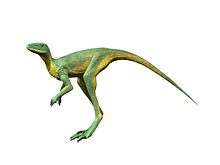Teyumbaita
Teyumbaita (meaning "lizard (Teyu´) and parrot (Mbaita´)" in the Brazilian aborigine Tupi-Guaraní language) is an extinct genus of hyperodapedontine rhynchosaur from the Upper Triassic (early Norian age) epoch of Paleorrota, Rio Grande do Sul, southern Brazil. Its fossils, two nearly complete skulls and a partial skull were discovered in the lower part of the Caturrita Formation and was first assigned to a species of Scaphonyx (now considered to be a nomen dubium), Scaphonyx sulcognathus. This species was reassigned to its own genus by Felipe Chinaglia Montefeltro, Max Cardoso Langer and Cesar Leandro Schultz in 2010 and the type species is Teyumbaita sulcognathus.[1] Fossil material of a second, yet-unnamed species, is known from the Hoyada del Cerro Las Lajas site of the Ischigualasto Formation (Argentina).[2]
| Teyumbaita | |
|---|---|
| Scientific classification | |
| Kingdom: | Animalia |
| Phylum: | Chordata |
| Class: | Reptilia |
| Order: | †Rhynchosauria |
| Family: | †Rhynchosauridae |
| Subfamily: | †Hyperodapedontinae |
| Genus: | †Teyumbaita Montefeltro, Langer and Schultz, 2010 |
| Species | |
| Synonyms | |
| |
Phylogeny
Cladogram based on Montefeltro, Langer and Schultz (2010):[1]
| Rhynchosauria |
| ||||||||||||||||||||||||||||||||||||||||||||||||
Material
Many specimens of T. sulcognathus have been found to date:[1]
- UFRGS-PV-0232T (holotype) - partial skeleton with nearly complete skull
- UFRGS-PV-0298T - partial skeleton and nearly complete skull
- UFRGS-PV-0290T - partial skeleton and skull
- UFRGS-PV-0418T - partial right mandible
- UFRGS-PV-0420T - partial right dentary and postcrania
- UFRGS-PV-0445T - partial maxilla
- MCP-683 - partial left dentary
References
- Felipe Chinaglia Montefeltro, Max Cardoso Langer and Cesar Leandro Schultz (2010). "Cranial anatomy of a new genus of hyperodapedontine rhynchosaur (Diapsida, Archosauromorpha) from the Upper Triassic of southern Brazil" (PDF). Earth and Environmental Science Transactions of the Royal Society of Edinburgh. 101: 27–52. doi:10.1017/S1755691010009060.
- Julia B. Desojo; Lucas E. Fiorelli; Martín D. Ezcurra; Agustín G. Martinelli; Jahandar Ramezani; Átila. A. S. Da Rosa; M. Belén von Baczko; M. Jimena Trotteyn; Felipe C. Montefeltro; Miguel Ezpeleta; Max C. Langer (2020). "The Late Triassic Ischigualasto Formation at Cerro Las Lajas (La Rioja, Argentina): fossil tetrapods, high-resolution chronostratigraphy, and faunal correlations". Scientific Reports. 10 (1): Article number 12782. doi:10.1038/s41598-020-67854-1. PMC 7391656. PMID 32728077.









